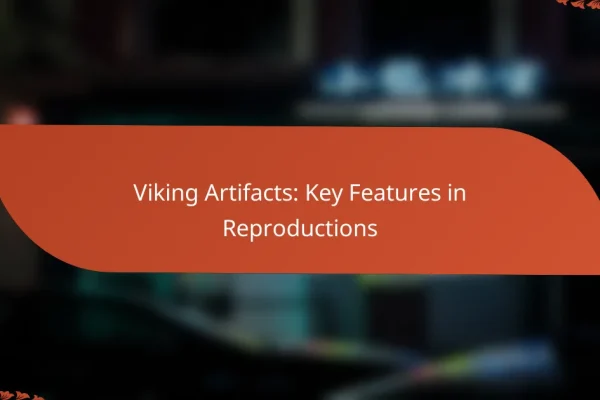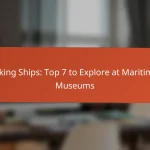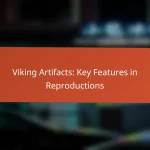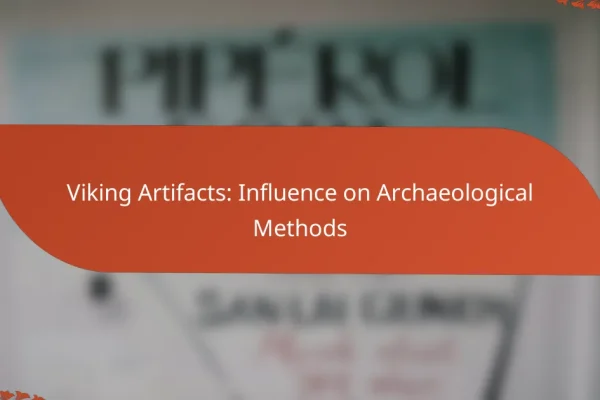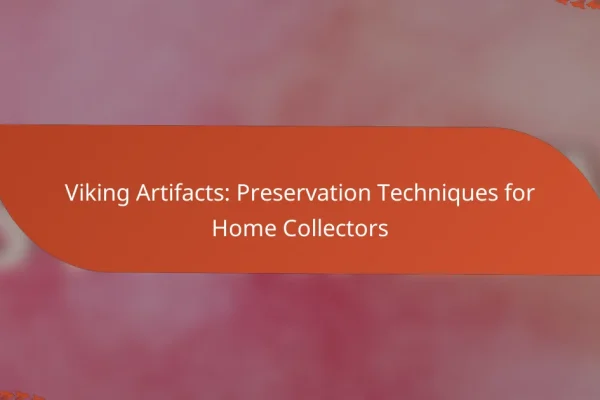What is the significance of Viking artifacts in Scandinavian history?
Viking artifacts are crucial for understanding Scandinavian history as they provide tangible evidence of the culture, economy, and beliefs of the Viking Age. These items reveal insights into the daily lives, trade practices, and spiritual values of the Norse people, shaping our comprehension of their historical impact.
Cultural insights into Viking society
The artifacts unearthed from Viking sites offer a window into their social structure, customs, and daily activities. Items such as tools, clothing, and household goods illustrate the craftsmanship and artistic skills of the Vikings, reflecting their values and priorities. For example, intricate jewelry and decorative items signify status and identity within their communities.
Additionally, burial artifacts, including weapons and personal belongings, provide insights into the beliefs surrounding death and the afterlife, showcasing the importance of honor and legacy in Viking culture.
Understanding trade and economy
Viking artifacts highlight the extensive trade networks established by the Norse, which stretched across Europe and beyond. Items such as coins, weights, and trade goods indicate the economic interactions between Vikings and other cultures, including the Byzantines and Arabs. This exchange facilitated not only the flow of goods but also ideas and technologies.
Artifacts like ship remnants further illustrate the Vikings’ maritime skills, essential for their trading ventures and exploration. The design and construction of their longships enabled them to navigate various waterways, enhancing their economic reach.
Religious and spiritual beliefs
Many Viking artifacts are linked to their religious practices and spiritual beliefs, including amulets, altars, and ritual items. These artifacts often depict Norse gods and mythological symbols, reflecting the importance of religion in everyday life. For instance, Thor’s hammer amulets were commonly worn as a sign of protection and faith.
Ritualistic artifacts found at burial sites reveal the significance of ceremonies and offerings, suggesting a complex belief system that included ancestor worship and a connection to nature.
Military and warfare implications
Artifacts related to warfare, such as weapons, armor, and shields, provide insights into the Viking approach to conflict and defense. The quality and craftsmanship of these items indicate a society that valued strength and skill in battle. Swords and axes often bore intricate designs, symbolizing both functionality and artistry.
The presence of fortifications and military equipment in archaeological sites suggests that the Vikings were not only raiders but also strategic planners who engaged in organized warfare. This understanding reshapes the narrative of Viking society as one that was both aggressive and sophisticated in military tactics.
How do Viking artifacts inform modern archaeology?
Viking artifacts provide crucial insights into the social, economic, and cultural practices of the Norse people, enhancing our understanding of their history. By studying these items, archaeologists can reconstruct past lifestyles, trade networks, and technological advancements.
Techniques in artifact recovery
Artifact recovery techniques vary widely, but common methods include excavation, surface collection, and underwater recovery. Excavation involves carefully digging at archaeological sites, often using tools like trowels and brushes to avoid damaging artifacts. Surface collection is simpler, relying on finding items on the ground, while underwater recovery requires specialized equipment for sites submerged in water.
Each technique has its advantages and challenges. Excavation can yield a wealth of information but is labor-intensive and time-consuming. Surface collection is quicker but may miss artifacts buried beneath the surface. Underwater recovery can uncover unique finds but requires diving expertise and can be limited by visibility and water conditions.
Dating methods and their accuracy
Dating methods for Viking artifacts include radiocarbon dating, dendrochronology, and stratigraphy. Radiocarbon dating is effective for organic materials, providing dates up to around 50,000 years old, while dendrochronology uses tree rings to date wooden artifacts accurately to the year. Stratigraphy relies on the layers of soil to determine the relative age of artifacts based on their depth.
Each method has varying degrees of accuracy and applicability. Radiocarbon dating is generally reliable but can be affected by contamination. Dendrochronology is precise but limited to wood, while stratigraphy can be subjective, depending on the excavation context. Combining these methods often yields the best results for establishing a timeline of Viking artifacts.
What are notable Viking artifacts found in Norway?
Notable Viking artifacts found in Norway include significant burial ships and weapons that provide insight into Viking culture and maritime practices. These artifacts, often excavated from burial sites, highlight the craftsmanship and societal structures of the Viking Age.
The Oseberg ship burial
The Oseberg ship burial, discovered in 1904, is one of the most famous Viking finds. This burial site contained a well-preserved ship, along with a wealth of grave goods, including textiles, tools, and animal remains, indicating the high status of the individuals buried there.
The ship itself is about 21 meters long and showcases advanced Viking shipbuilding techniques. Its ornate carvings and design reflect the artistic skills of the time, making it a crucial piece of Viking heritage.
The Gokstad ship
The Gokstad ship, excavated in 1880, is another remarkable Viking artifact that reveals much about Viking seafaring capabilities. Measuring approximately 23 meters in length, this ship was built for speed and agility, ideal for raids and exploration.
Similar to the Oseberg ship, the Gokstad burial included various artifacts, such as weapons and household items, which provide insights into the daily life and customs of the Vikings. Its design influenced later shipbuilding in Northern Europe.
Viking swords and weapons
Viking swords and weapons are significant artifacts that illustrate the martial culture of the Vikings. Many swords, often inscribed with runes, were crafted with high-quality iron and sometimes included gold or silver inlays, showcasing the artistry and skill of Viking blacksmiths.
Common types of weapons include axes, spears, and shields, each serving specific purposes in battle. The craftsmanship of these weapons not only reflects the technological advancements of the time but also the importance of warfare in Viking society.
How do Viking artifacts reflect social hierarchy?
Viking artifacts provide insight into the social hierarchy of their society, showcasing the distinctions between the elite and common people. The materials, craftsmanship, and types of items found reveal the status and wealth of their owners.
Artifacts of the elite
Elite Viking artifacts often include finely crafted weapons, intricate jewelry, and ornate household items. These artifacts were typically made from precious metals like gold and silver, demonstrating wealth and power. For example, a high-status individual might possess a beautifully decorated sword or a brooch adorned with gemstones.
Additionally, burial practices for the elite often involved lavish grave goods, which could include ships, tools, and personal items intended for use in the afterlife. Such elaborate burials highlight the importance of status and the belief in an afterlife among the Viking nobility.
Common items and their significance
Common Viking artifacts include everyday tools, pottery, and simple jewelry, which reflect the daily lives of the majority. Items like iron tools and basic ceramics were essential for survival, indicating the skills and trades of the common people. These artifacts often reveal practical aspects of Viking life, such as farming, cooking, and craftsmanship.
While less ornate than elite artifacts, common items still hold significance as they demonstrate the social structure and community roles within Viking society. For instance, a simple brooch might signify a person’s trade or local identity, emphasizing that status was not solely defined by wealth but also by contributions to the community.
What role do Viking artifacts play in contemporary culture?
Viking artifacts significantly influence contemporary culture by shaping our understanding of history and inspiring modern creativity. These relics serve as a bridge to the past, informing art, design, and cultural events that celebrate Viking heritage.
Influence on modern art and design
Viking artifacts inspire a variety of modern art forms, from sculpture to graphic design. Artists often draw on the intricate patterns and motifs found in Viking jewelry and weaponry, incorporating these elements into contemporary works. For example, the use of Norse symbols in tattoos and fashion reflects a growing appreciation for Viking aesthetics.
Designers also utilize Viking themes in home decor, creating items such as furniture and textiles that echo the rugged beauty of Viking craftsmanship. This trend is especially popular in Scandinavian countries, where there is a strong cultural connection to Viking history.
Viking-themed events and tourism
Viking-themed events and festivals attract tourists and locals alike, celebrating Norse culture through reenactments, markets, and educational activities. Events like the Viking Festival in Lofotr, Norway, offer immersive experiences where attendees can learn about Viking life, crafts, and traditions.
Tourism related to Viking history is booming, with many sites across Scandinavia, such as the Viking Ship Museum in Oslo, Norway, and the Jelling Stones in Denmark, drawing visitors interested in exploring their heritage. These attractions often feature guided tours, workshops, and exhibitions that highlight the significance of Viking artifacts in understanding the past.
How are Viking artifacts preserved and displayed?
Viking artifacts are preserved through various conservation techniques and displayed in museums dedicated to showcasing their cultural significance. These methods ensure the longevity of the artifacts while allowing the public to appreciate their historical context.
Conservation techniques
Conservation techniques for Viking artifacts include careful cleaning, stabilization, and climate control. Artifacts made from organic materials, like wood or textiles, often require specific humidity and temperature settings to prevent deterioration.
Common methods involve using chemical treatments to prevent corrosion on metal items and applying protective coatings to fragile surfaces. Regular monitoring is essential to detect any signs of damage early and to implement corrective measures.
Museums showcasing Viking heritage
Numerous museums around the world focus on Viking heritage, with notable examples including the Viking Ship Museum in Oslo, Norway, and the National Museum of Denmark in Copenhagen. These institutions curate extensive collections of artifacts, providing insights into Viking life, trade, and exploration.
Many museums also offer interactive exhibits and educational programs, enhancing visitor engagement. Some institutions may rotate displays to highlight different aspects of Viking culture, ensuring a dynamic experience for returning guests.
What emerging trends are shaping the study of Viking artifacts?
Emerging trends in the study of Viking artifacts include advancements in digital archaeology and interdisciplinary research approaches. These trends enhance the understanding of Viking culture and improve methods for analyzing artifacts.
Digital archaeology advancements
Digital archaeology is revolutionizing how researchers study Viking artifacts by utilizing technologies like 3D scanning, virtual reality, and geographic information systems (GIS). These tools allow for detailed documentation and analysis of artifacts without physical handling, preserving their integrity.
For instance, 3D models can be created from scans of artifacts, enabling researchers to share and study them globally. This accessibility fosters collaboration and allows for more comprehensive analyses, such as virtual reconstructions of Viking settlements.
Interdisciplinary approaches in research
Interdisciplinary approaches combine insights from history, archaeology, anthropology, and even natural sciences to provide a richer understanding of Viking artifacts. By integrating different fields, researchers can uncover connections between artifacts and the social, economic, and environmental contexts of the Viking Age.
For example, collaboration with scientists can reveal information about the materials used in artifacts, such as their origins and manufacturing techniques. This holistic view can lead to new interpretations of Viking culture and trade networks.
